CalAmp 500004 Wireless Communications Module - WiMetry User Manual Integration Manual
CalAmp Corp. Wireless Communications Module - WiMetry Integration Manual
CalAmp >
Integration Manual
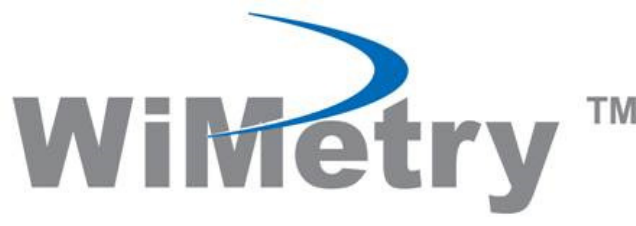
WiMetry
TM
Core Module
Installation Guide
R1.1
Copyright Notice
©2009 CalAmp Corp. All Rights Reserved.
This guide covers the installation of the CalAmp WiMetry Core Module. Specifications described are
typical only and are subject to normal manufacturing and service tolerances.
CalAmp reserves the right to modify the equipment, its specification or this manual without prior
notice, in the interest of improving performance, reliability or servicing. At the time of publication all
data is correct for the operation of the equipment at the voltage and/or temperature referred to.
Performance data indicates typical values related to the particular product. No part of this
documentation or information supplied may be divulged to any third party without the express written
consent of CalAmp Corp.
Products offered may contain software which is proprietary to CalAmp Corp. The offer or supply of
these products and services does not include or infer any transfer of ownership.

FCC Statements
This device complies with Part 15 of the FCC Rules. Operation is subject to the following two
conditions: (1) This device may not cause harmful interference, and (2) This device must accept any
interference received, including interference that may cause undesired operation.
This equipment has been tested and found to comply with the limits for Class B Digital Device,
pursuant to Part 15 of the FCC Rules. These limits are designed to provide reasonable protection
against harmful interference in a residential installation. This equipment generates and can radiate
radio frequency energy and, if not installed and used in accordance with the instructions, may cause
harmful interference to radio communications. However, there is no guarantee that interference will
not occur in a particular installation. If this equipment does cause harmful interference to nearby
electrical devices, the user is encouraged to try to correct the interference by one or more of the
following measures.
• Reorient or relocate the receiving antenna
• Increase the separation between the equipment and receiver
• Connect the equipment into an outlet on a circuit different from that to which the receiver is
connected
• Consult CalAmp technical support for help
Any changes or modifications not expressly approved by the party responsible for compliance could
void the user’s authority to operate the equipment.
To comply with FCC regulations for the device, the following rules must be obeyed during and after
installation
Keep the cellular antenna of the Cell Module at a safe distance from your head and body while the
modem is in use. Maintain a distance of at least 20 cm (8 inches) between the transmitter’s antenna
and any person while in use. This device is designed for use in applications that observe the 20 cm
separation distance. Consult the Cell Module installation guide for information on approved antennas.
Non-Collocation for External Antenna
External antenna must not be collocated or operating in conjunction with any other antenna or
transmitter. Collocation is defined as any antenna or radiating element positioned within 20cm
of another antenna or radiating element.
The supplied internal antenna for 802.15 will insure 20cm separation from a properly mounted,
vertically positioned external cellular antenna.
Only FCC approved antennae can be used with the 802.15 transceiver. Consult with CalAmp, Corp.
or FCC OET website, www.fcc.gov/oet/, for a list of approved antenna solutions for this device.
Safety Issues
The use of cellular telephones or devices in aircraft is illegal. Use in aircraft may endanger operation
and disrupt the cellular network. Failure to observe this restriction may result in suspension or denial
of cellular services to the offender, legal action or both.
Do not operate in the vicinity of gasoline or diesel-fuel pumps unless use has been approved
and authorized
Do not operate in locations where medical equipment that the device could interfere with may
be in use
Do not operate in fuel depots, chemical plants, or blasting areas unless use has been approved
and authorized
Use care if operating in the vicinity of protected personal medical devices, i.e., hearing aids and
pacemakers
Operation in the presence of other electronic equipment may cause interference if equipment
is incorrectly protected. Follow recommendations for installation from equipment
manufacturers.
Contents
1. OVERVIEW ........................................................................................................................................ 6
1.1. Advisory Symbols ......................................................................................................................... 6
1.2. Module Identification ................................................................................................................... 6
1.3. General Description...................................................................................................................... 7
1.4. External Connectors ..................................................................................................................... 8
2. EXTERNAL INTERFACES ................................................................................................................... 10
2.1. Power Connection ...................................................................................................................... 10
2.2. EIA-232 DB-9 connector ............................................................................................................. 11
2.3. External I/O ................................................................................................................................ 12
2.4. Meter Interface Connector (P6) ................................................................................................. 14
2.5. Status LEDs ................................................................................................................................. 15
2.6. COTS Interfaces .......................................................................................................................... 15
Ethernet ............................................................................................................................................ 16
USB Device ........................................................................................................................................ 16
USB Host............................................................................................................................................ 16
2.7. Cellular Module .......................................................................................................................... 16
2.8. 802.15 Antenna .......................................................................................................................... 16
3. GENERAL INSTALLATION GUIDELINES ............................................................................................ 17

1. OVERVIEW
1.1. Advisory Symbols
Warning! Improper usage or handling may cause non-compliant device operation.
Warning! High voltage presents risk of injury due to electric shock.
Direct Current (DC).
1.2. Module Identification
The label contains the CalAmp part number, serial number, IC and FCC ID numbers. Additional labeling
will be required on the end device.

1.3. General Description
The CalAmp WiMetry
TM
Core Module is an Internet Protocol-based, bidirectional wireless data
concentrator platform used for advanced metering and demand response monitoring and control
applications. The platform also has other smart grid applications and facilitates real-time acquisition of
critical usage and rate data from electric, gas or water meters via public wireless networks and the
Internet.
The WiMetry
TM
platform supports the latest in cellular 3G high-speed data communications and is
backward compatible to existing EV-DO Rev. 0 and 1x networks. WiMetry
TM
takes advantage of
ongoing investments made by cellular network operators to build-out, improve and maintain
ubiquitous, reliable wireless networks using the latest standards, thereby enabling utility companies to
focus on their core business rather than having to establish their own proprietary wireless networks.
The Core Module is designed to be easily integrated into various end devices. This document describes
the process and rules for integrating the core module into an end device. It includes descriptions of
all external interfaces and instruction on how to communicate and power the device. This document
does not cover the software functionality of the device. Refer to end product documentation for more
information on the application software.
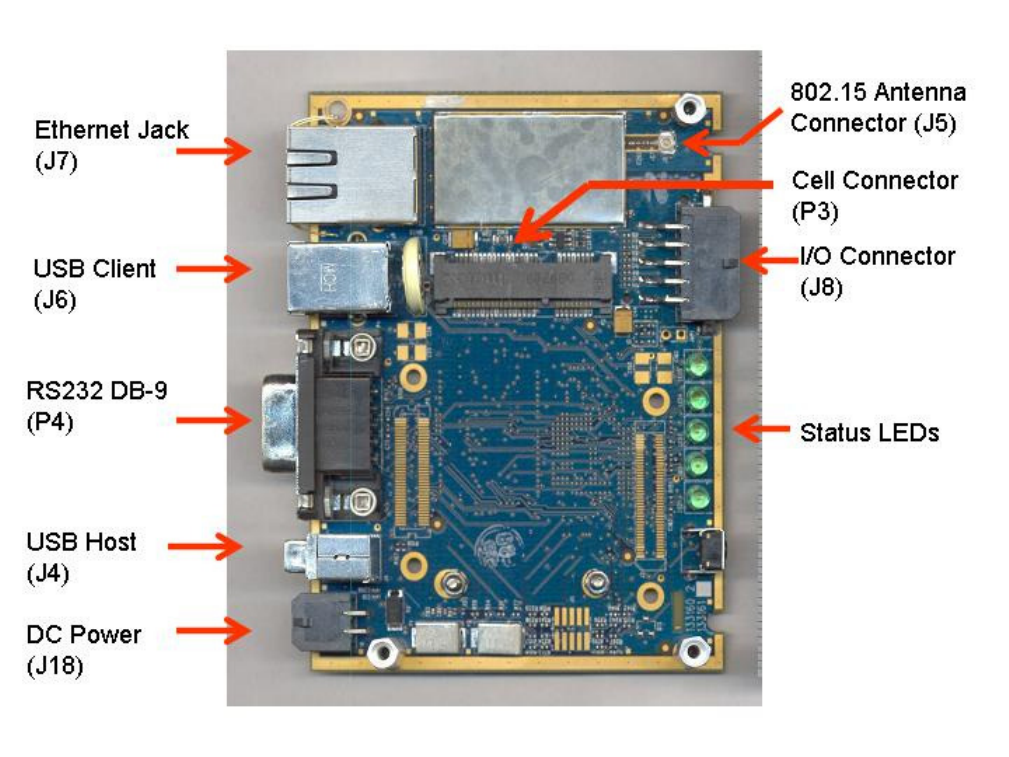
1.4. External Connectors
See the images below for location of external connectors.
Figure 1: Top View of Core Module
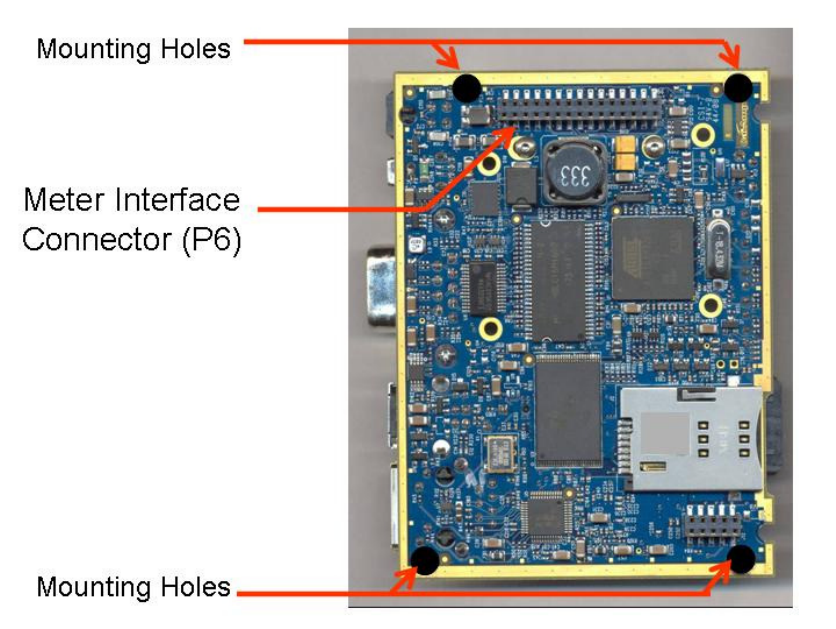
Figure 2: Bottom View of Core Module
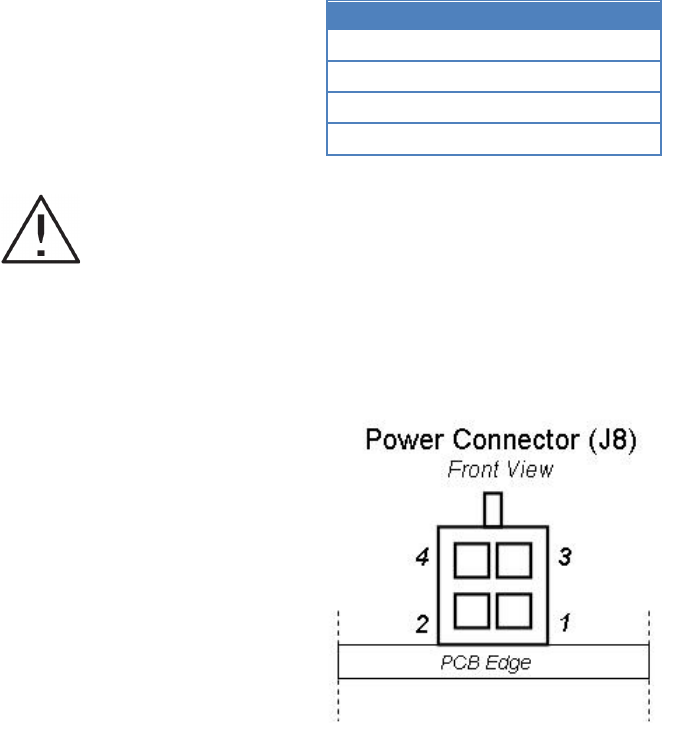
2. EXTERNAL INTERFACES
2.1. Power Connection
The connector on the core module is the Molex 43045-0401:
The mating connector (required for the power cable) is the Molex 43025-0400.
The contact required on the mating cable is the Molex 43030-0002
The core module is powered either from the J18 power connector or from the Meter Interface
Connector. The pinout of the J18 power connector is below. The pinout of the Meter Interface
Connector is in its own section. For specifications on the digital input, see the External I/O section.
Table 1: DC Power Connector (J18)
Pin
Signal
1 V_IN (9-28VDC)
2 GND
3 DIGITAL_IN4
4 NO CONNECT
Note: Do not connect independent power supplies to the power connector and the power
inputs on the Interface Board Connector (P6). The power inputs are shorted on the core
module and connecting both could cause a high current condition.
Pinout
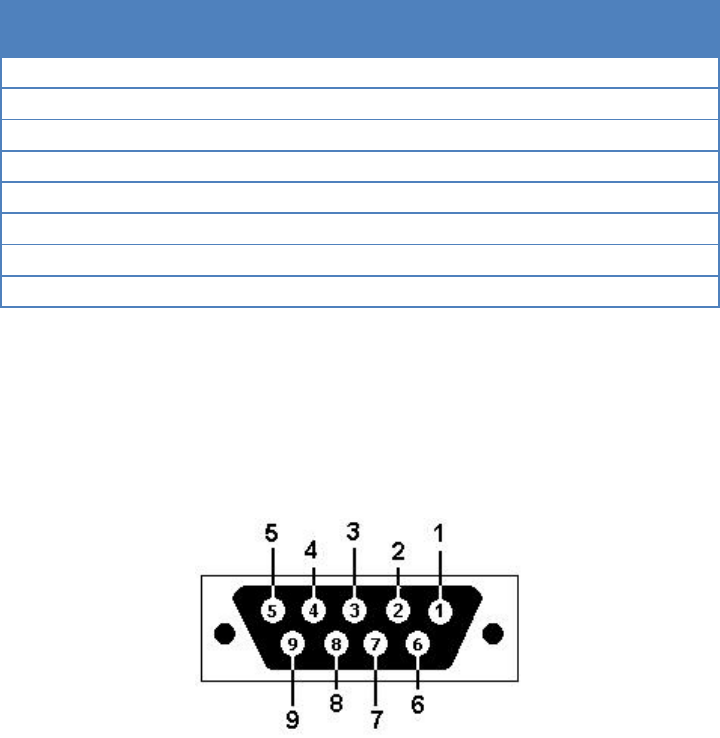
2.2. EIA-232 DB-9 connector
The concentrator contains a standard DB-9 female serial port connector that contains all the required
signals for EIA-232 serial communication per the EIA-232 specification.
The table below provides the information to purchase or cables to connect to the DB-9 female
connector on the core module.
Note: All signal names and directions are from the perspective of the core module
Table2 : DB9 EIA-232 Pin-out (P4)
Function
Pinout DB9 female
(Port 1 only)
Direction
DCE Ready DSR 6 Output
Line Signal Detect 1 Input
Clear to Send (CTS) 7 Input
Receive* 3 Input
Request to Send (RTS) 8 Output
Transmit* 2 Output
Ground* 5 NA
DTE Ready (DTR) 4 Input
* Required Signal
Pinout
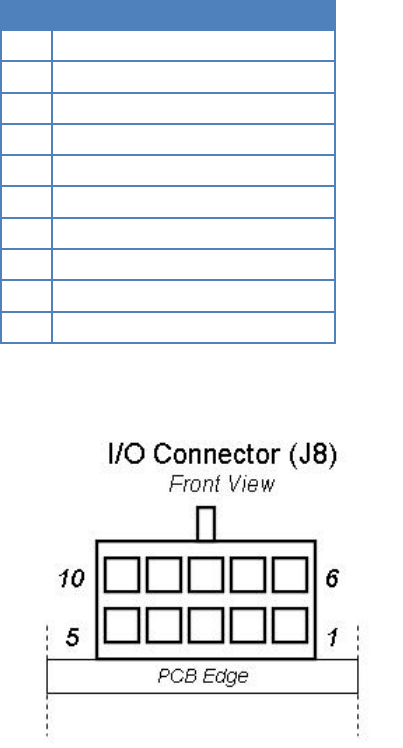
2.3. External I/O
The Core Module contains a variety of digital and analog external I/O. This I/O can be used to interface
with external sensor or logic.
The connector on the core module is the Molex 43045-0101:
The mating connector (required for the power cable) is the Molex 43025-1000.
The contact required on the mating cable is the Molex 43030-0002
Table 3: I/O Connections (J8)
Pin
Signal
1 DIGITAL OUT 2
2 DIGITAL GND
3 DIGITAL IN 3
4 ANALOG GND
5
ANALOG IN 3
6
DIGITAL OUT 1
7
DIGITAL IN 2
8
DIGITAL IN 1
9
ANALOG IN 1
10
ANALOG IN 2
Pinout
External I/O Specifications:
Analog Inputs:
Input Voltage Range: 0-28VDC, 10-bit resolution
Digital Inputs:
Input Voltage Range: 0-28VDC, 1.5V logic threshold
Digital Outputs:
Open Collector Outputs, 0-28VDC, 1Amp max current

2.4. Meter Interface Connector (P6)
The Meter Interface connector is Samtec MMS-115-02-L-DV
The Mating Connector to the Meter interface Connector is the Samtec TW-15-07-L-D-570-090. This
connector is a surface mount connector and must be mounted to a mating PCB.
Table 4: MIB Pinout
Pin
Signal
Direction
Function
1 V_IN (9-28VDC) NA
2 GND NA
3 V_IN (9-28VDC) NA
4 GND NA
5 /MIB_AC_MON Input Indicates the presence of AC voltage input (active
low)
6 /DB9_DISABLE Input Drive low to indicate the presence of a interface
board
7 /MIB_BATT_MON Input Indicates the presence of Battery voltage input (active
low)
8 /MIB_DIAB_PB Input Force the core module to run a diagnostic check
(active low)
9 /MIB_OTA_PB Input Force the core module’s cell module to perform an
over the air activation
10 IO_DIN3 Input General Purpose Digital Input
11 DOUT3 Output General Purpose Digital Output (0-3.3VDC)
12 DOUT4 Output General Purpose Digital Output (0-3.3VDC)
13 MIB_METER_TYPE Output Indicates the type of meter the board is
communicating with (See MIB Meter Type)
14 MIB_232_485 Output Controls the communication type; RS232 (logic high)
or RS485 (logic low)
15 MIB_485_DIR Output Controls the direction of the RS485 transceiver,
transmit (active high), receive (active low)
16 MIB_485_4W/2W Output Commands the RS485 to be a 4 wire (active high) or 2
wire (active low) interface
17 MIB_232_PORT_A2 Output MUX driver that controls which serial port (1-8) is
active.
18 MIB_232_PORT_A1 Output MUX driver that controls which serial port (1-8) is
active.
19 MIB_232_PORT_A0 Output MUX driver that controls which serial port (1-8) is
active.
20 MIB_DCE_TXD Input RS232 Receive Line
21 MIB_DCE_RXD Output RS232 Transmit Line
22 DCE_RTS Input RS232 Clear to Send Line
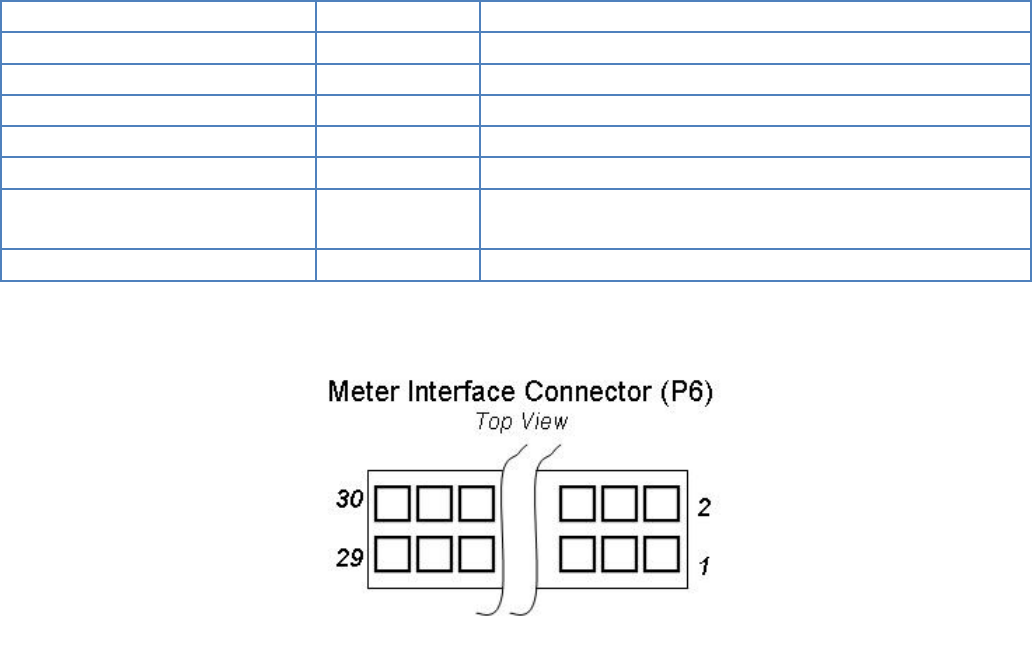
23 DCE_CTS Output RS232 Request to Send Line
24 DCE_DTR Input RS232 Data Set Ready
25 DCE_DSR Output RS232 Data Terminal Ready
26 DCE_RI Output RS232 Ring Indicator
27 DCE_DCD Output RS232 Data Carrier Detect
28 NO CONNECT NA
29 AT91_BMS Input Boot Mode Select: Internal (Active High), External
(Active Low)
30 NO CONNECT NA
Pinout
2.5. Status LEDs
Status LEDs are installed on the Core Module.
LEDs on the Core Module
LED1(802.15): Indicates activity on the 802.15 link
LED2(Signal): Indicates a sufficient RSSI on the cell signal
LED3(Activity): Shows activity on the cellular link
LED4(Service): The unit has connected to a cellular network
LED5(Power): The Core Module is powered
2.6. COTS Interfaces
The following interfaces are industry standard and use off the shelf cables for communication. No
customization is required.

Ethernet
Auto-Negotiating, Auto-MDIX, 10/100Mbps Ethernet LAN interface via an RJ-45 connector, with
status indicators.
USB Device
USB v2.0, Low or Full speed, Device port via a Type-B style connector.
USB Host
USB v2.0, Low or Full speed, Host port via a Type-A style connector.
2.7. Cellular Module
The Core Module contains a mini PCI express connector (P3) for connecting a 3G cell module. CalAmp
will install the cell module prior to shipment. The Cell module will contain its own unique antenna
connector and installation requirements.
Refer to cell module manufacturer product documentation for installation rules and
antenna options with regards to FCC certification.
2.8. 802.15 Antenna
To insure FCC compliance, the Core Module 802.15 modular transmitter utilizes a U.FL antenna coupler
and requires a unique coaxial feed assembly direct to the external antenna. Any antenna used with
the module must meet certification requirements.
To comply with FCC approval for the EVDO device, do not use a 2.4GHZ antenna with a
gain greater than 2dBi.
To comply with FCC approval for the device, do not place the 802.15 antenna within 20cm
of the cellular antenna or any other antennas in the system.
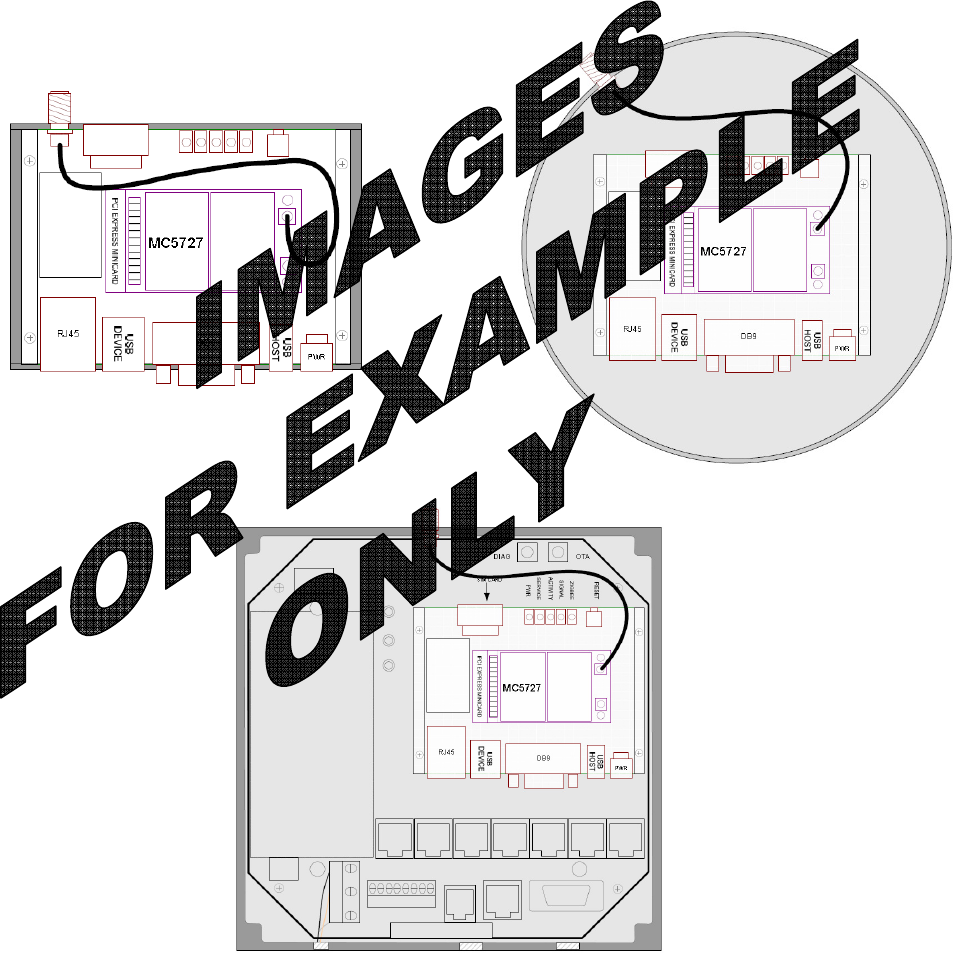
3. GENERAL INSTALLATION GUIDELINES
Refer to module overview images, Figures 1 and 2, for locations of mounting holes.
The core module is mounted using the four mounting holes on the corners of the module using #4
screws.
Although not necessary for emissions compliance, it is recommended that each mounting hole or the
associated edge copper rails are electrically connected to the chassis ground of the assembly
enclosure.
Minimum single-shielded coax is required for emissions compliance of both cellular and 802.15
antenna feeds. Cables should route across top side of board, preferably outside of PWA perimeter.
Enclosures and cable feed recommendations are shown below.
This page intentionally left blank.